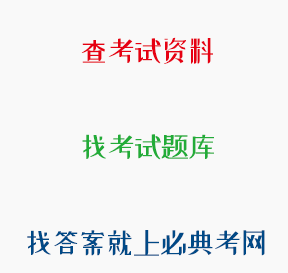正确答案: B
收复台湾
题目:下列选项中,体现郑成功重大历史功绩的一项是( )。
解析:B选项,收复台湾:清康熙年间,民族英雄郑成功从荷兰殖民者手中收复台湾。故选择B。A选项,虎门销烟:1839年6月林则徐在广东虎门集中销毁鸦片,后来成为1840年第一次鸦片战争的导火线。C选项,官渡之战:东汉末年,曹操和袁绍在官渡大战,曹操战胜,奠定了曹操统一中国北D选项,的基础。七擒孟获:三国时期是诸葛亮征伐西南少数民族。
查看原题 查看所有试题
学习资料的答案和解析:
[单选题]中学生王某扰乱课堂秩序,教师刘某将其赶出教室并罚王某做俯卧撑,王某体力不支,头部磕伤,下列选项中正确的是( )。
刘某侵犯了王某的受教育权和人身权
解析:教师刘某将王某赶出教室,不让他听课,侵犯了其受教育的权利;对王某进行体罚,侵犯了其人身权。故选择D。
[单选题]如果"有的明星不会使用计算机"是一个真判断,下面不能确定其真假的是( )。
有的明星会使用计算机
解析:由"有些明星不会使用计算机"为真可知,"至少有一个明星不会使用计算机"也为真,而"所有的明星都会使用计算机"为假,原句换位推理可得"不会使用计算机的有些是明星"为真:只有"有些明星会使用计算机"无法判断真假,故选择C项。
[单选题]暑假里,小张的父母给小张报了摄影兴趣班和美术兴趣班。小张知道后说,以后我又不想成为摄影家,何必学摄影。以下哪项是小张的回答中包含的前提?( )
只有想成为摄影家,才需要学摄影
解析:此题考查假言命题的推理规则。小张的的意思为"不想成为摄影家一不必学摄影",若要这句话为真,则需要"学摄影一想成为摄影家"为真,故选择C项。
[单选题]"校园文化"属于( )课程。
隐性课程
解析:隐性课程,亦称潜在课程、自发课程,是学校情境中以间接的、内隐的方式呈现的课程,如师生关系、校风、学风等。题目中提及的"校园文化"是隐性课程,故选择C。A选项,学科课程也称分科课程,是一种主张以学科为中心来编定的课程。主张课程要分科设置,分别从相应科学领域中选取知识,根据教育教学需要分科编排课程,进行教学。B选项,活动课程是按课程组织形式的不同划分的,又称儿童中心课程、经验课程,它打破学科逻辑组织的界限,从儿童的兴趣和需要出发,以活动为中心。D选项,核心课程是围绕一些重大的社会问题组织教学内容,社会问题就像包裹在教学内容里的果核一样,又被称为问题中心课程。
[单选题]请阅读Passage 1,完成1~5小题。
Passage 1
Today's adults grew up in schools designed to sort us into the various segments of our social and economic system.The amount of time available to learn was fixed: one year per grade.The amount learned by the end of that time was free to vary: some ofus leamed a great deal; some,very little.As we advanced through the grades,those who had learned a great deal in previous grades continued to build on those foundations.Those who had failed to master the early prerequisites within the allotted time failed to learn that which followed.After 12 or 13 years of cumulative treatment of this kinD.we were,in effect,spread along an achievement continuum that was ultimately reflected in each student's rank in class upon graduation.
From the very earliest grades,some students learned a great deal very quickly and consistently scored high on assessments.The emotional effect of this was to help them to see themselves as capable learners,and so these students became increasingly confident in school.That confidence gave them the inner emotional strength to take the risk of striving for more success because they believed that success was within their reach.Driven forward by this optimism,these students continued to try harD.and that effort continued to result in success for them.They became the academic and emotional winners.Notice that the trigger for their emotional strength and their learning success was their perception of their success on formal and informal assessments.
But there were other students who didn't fare so well.They scored very low on tests,beginning in the earliest grades.The emotional effect was to cause them to question their own capabilities as learners.They began to lose confidence,which,in turn,deprived them of the emotional reserves needed to continue to take risks.As their motivation warneD.of course,their performance plummeted.These students embarked on what they believed to be an irreversible slide toward inevitable failure and lost hope.Once again,the emotional trigger for their decision not to try was their perception of their performance on assessments.
Consider the reality-indeed.the paradox-of the schools in which we were reared.If some students worked hard and learned a lot,that was a positive result,and they would finish high in the rank order.But if some students gave up in hopeless failure,that was an acceptable result,too, because they would occupy places very low in the rank order.Their achievement results fed into the implicit mission of schools: the greater the spread of achievement among students,the more it reinforced the rank order.This is why,if some students gave up and stopped trying (even dropped out of school),that was regarded as the student's problem,not the teacher's or the school's.
Once again,please notice who is using test results to decide whether to strive for excellence or give up in hopelessness.The "data-based decision makers" in this process are students themselves.Students are deciding whether success is within or beyond reach,whether the learning is worth the required effort,and so whether to try or not.The critical emotions underpinning the decision making process include anxiety,fear of failure,uncertainty,and unwillingness to take risks-all triggered by students' perceptions of their own capabilities as reflected in assessment results.
Some students responded to the demands of such environments by working hard and learning a great deal.Others controlled their anxiety by giving up and not caring.The result for them is exactly the opposite of the one society wants.Instead of leaving no child behinD.these practices,in effect,drove down the achievement of at least as many students as they successfully elevated.And the evidence suggests that the downside victims are more frequently members of particular socioeconomic and ethnic minorities.
What is the author's attitude towards the old mission of assessment?
Negative.
解析:态度题。作者在第二、三段分别阐述了学校的评估对于学习好的学生和学习不好的学生的情感效应,即学习好的学生越来越积极,学习不好的学生越来越消极。第四段提到即使学生成绩不好甚至辍学,这也被认为是学生自己的问题,而不是学校或教师的责任。作者的观点是学校不该让学生越来越消极。通过整篇的用词诸如最后一段“the downside victims”等可知,作者对于学校旧的评估工作是持消极态度的。故本题选C。

 川公网安备 51012202001360号
川公网安备 51012202001360号